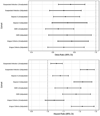Patient Outcomes and Cost-Effectiveness of a Sepsis Care Quality Improvement Program in a Health System
- PMID: 31306176
- PMCID: PMC7195842
- DOI: 10.1097/CCM.0000000000003919
Patient Outcomes and Cost-Effectiveness of a Sepsis Care Quality Improvement Program in a Health System
Abstract
Objectives: Assess patient outcomes in patients with suspected infection and the cost-effectiveness of implementing a quality improvement program.
Design, setting, and participants: We conducted an observational single-center study of 13,877 adults with suspected infection between March 1, 2014, and July 31, 2017. The 18-month period before and after the effective date for mandated reporting of the sepsis bundle was examined. The Sequential Organ Failure Assessment score and culture and antibiotic orders were used to identify patients meeting Sepsis-3 criteria from the electronic health record.
Interventions: The following interventions were performed as follows: 1) multidisciplinary sepsis committee with sepsis coordinator and data abstractor; 2) education campaign; 3) electronic health record tools; and 4) a Modified Early Warning System.
Main outcomes and measures: Primary health outcomes were in-hospital death and length of stay. The incremental cost-effectiveness ratio was calculated and the empirical 95% CI for the incremental cost-effectiveness ratio was estimated from 5,000 bootstrap samples.
Results: In multivariable analysis, the odds ratio for in-hospital death in the post- versus pre-implementation periods was 0.70 (95% CI, 0.57-0.86) in those with suspected infection, and the hazard ratio for time to discharge was 1.25 (95% CI, 1.20-1.29). Similarly, a decrease in the odds for in-hospital death and an increase in the speed to discharge was observed for the subset that met Sepsis-3 criteria. The program was cost saving in patients with suspected infection (-$272,645.7; 95% CI, -$757,970.3 to -$79,667.7). Cost savings were also observed in the Sepsis-3 group.
Conclusions and relevance: Our health system's program designed to adhere to the sepsis bundle metrics led to decreased mortality and length of stay in a cost-effective manner in a much larger catchment than just the cohort meeting the Centers for Medicare and Medicaid Services measures. Our single-center model of interventions may serve as a practice-based benchmark for hospitalized patients with suspected infection.
Figures



Comment in
-
More Than We Bargained For: The "Dominating" Cost Effectiveness of Sepsis Quality Improvement?Crit Care Med. 2019 Oct;47(10):1464-1467. doi: 10.1097/CCM.0000000000003944. Crit Care Med. 2019. PMID: 31524700 No abstract available.
-
Potential Confounders for Applying a Novel Sepsis Care Quality Improvement Program.Crit Care Med. 2020 Feb;48(2):e161-e162. doi: 10.1097/CCM.0000000000004069. Crit Care Med. 2020. PMID: 31939826 No abstract available.
-
The authors reply.Crit Care Med. 2020 Feb;48(2):e162-e163. doi: 10.1097/CCM.0000000000004106. Crit Care Med. 2020. PMID: 31939827 Free PMC article. No abstract available.
References
-
- Burchardi H and Schneider H. Economic aspects of severe sepsis: a review of intensive care unit costs, cost of illness and cost effectiveness of therapy. Pharmacoeconomics. 22:793–813. - PubMed
-
- Septimus EJ, Coopersmith CM, Whittle J, Hale CP, Fishman NO and Kim TJ. Sepsis National Hospital Inpatient Quality Measure (SEP-1): Multistakeholder Work Group Recommendations for Appropriate Antibiotics for the Treatment of Sepsis. Clin Infect Dis. 2017;65:1565–1569. - PubMed
-
- Lee SH, Hsu TC, Lee MG, et al. Nationwide Trend of Sepsis: A Comparison Among Octogenarians, Elderly, and Young Adults. Crit Care Med. 2018;46:926–934. - PubMed
Publication types
MeSH terms
Grants and funding
LinkOut - more resources
Full Text Sources
Medical
Miscellaneous

